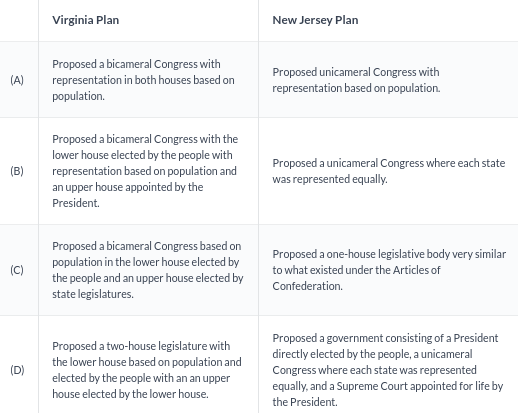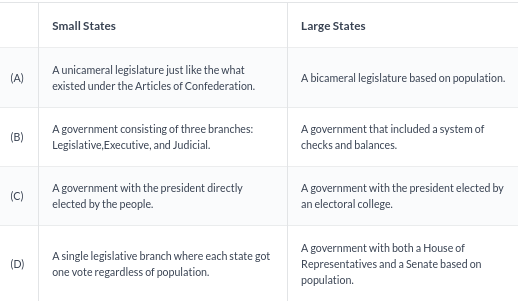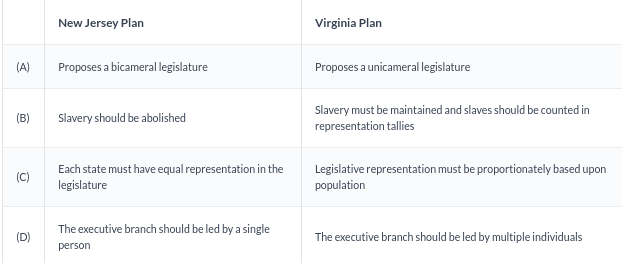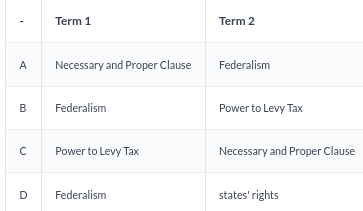AP gov: quiz 1.2 review flashcards
1/29
There's no tags or description
Looks like no tags are added yet.
Name | Mastery | Learn | Test | Matching | Spaced |
|---|
No study sessions yet.
30 Terms

To ensure ratification of the Constitution there were many compromises between Federalists and Anti-Federalists that needed to be accomplished. Which set of comparisons below most accurately reflect the final resolutions each group desired?
Row A
Row B
Row C
Row D
Row B

Which of the following comparisons about the New Jersey Plan and the Virginia Plan are the most accurate?
Row A
Row B
Row C
Row D
Row C

Which of the following is the most accurate comparison about the goals of small states and large states ameliorated by Great Compromise at the Constitutional Convention?
Row A
Row B
Row C
Row D
Row B
The ability to compromise helped secure ratification of the Constitution proposed in 1787, but left many matters unresolved that still generate intense debates today. Which of the following scenarios best exemplifies an issue that the compromises at the Constitutional Convention did not resolve?
The issue that sometimes state and federal law are in conflict with each other. For example, under federal law, marijuana is illegal, yet many states have legalized its use for medicinal or recreational purposes.
The issue that sometimes the law does not reflect reality. The Equal Pay Act of 1963 makes it illegal to discriminate in wages on the account of sex, yet women on average still are not paid the same wages as males in the United States for the same type of work.
The issue that representation should address differently sized populations. For example, due to its large population, California has more representation than any other state in the House of Representatives giving it more power in deciding federal legislation than any other state.
The issue that the Supreme Court justices should be able to rule on the constitutionality of legislation. For example, The Supreme Court, through its power of Judicial Review enumerated in Article III of the Constitution overturns a state law banning same-sex marriage.
The issue that sometimes state and federal law are in conflict with each other. For example, under federal law, marijuana is illegal, yet many states have legalized its use for medicinal or recreational purposes.
Which of the following contentious relationships did the Connecticut Compromise (or “Great Compromise”) do the most to quell?
States with large populations versus states with small populations
States with a lot of war debt versus states with little war debt
Federalists versus anti-Federalists
Proponents of a strong executive versus proponents of a weak executive
States with large populations versus states with small populations

Which of the following correctly identifies characteristics of the New Jersey Plan and the Virginia Plan?
Row A
Row B
Row C
Row D
Row C
Based on Federalist No. 51, which of the following can best be inferred about one of the three branches of the federal government?
The legislative branch should continue to be unicameral.
Candidates for the judiciary branch may require special qualifications and appointment.
The power of the executive branch should be limited significantly.
The three branches of government should cooperate in staffing each other's department.
Candidates for the judiciary branch may require special qualifications and appointment.
A member of Congress has proposed an amendment to the Constitution to revise the 2nd Amendment. Which of the following options best describes what would have to happen for this proposed change to 2nd Amendment to take effect?
The proposed change to the 2nd Amendment would need to be passed by a 2/3rd majority in both the House and Senate and signed by the President before it would take effect.
The proposed change to the 2nd Amendment would need to be passed by a 2/3rd majority in both the House and Senate and ratified by 3/4ths of the State Legislatures.
The proposed change to the 2nd Amendment would need to be passed by a 3/4ths majority in both the House and Senate and ratified by a super-majority of the State Legislatures.
The proposed change to the 2nd Amendment would need to be passed by a simple majority in both the House and Senate and ratified unanimously by the State Legislatures.
The proposed change to the 2nd Amendment would need to be passed by a 2/3rd majority in both the House and Senate and ratified by 3/4ths of the State Legislatures.
Which of the following scenarios could result in changes to the U.S. Constitution without the support of Congress?
Upon application of at least 2/3rds of the State Legislatures for a new amendment, a Constitutional Convention can be held where delegates from the states can vote on the amendment. The amendment must be ratified by 3/4ths of the delegates present to become part of the Constitution.
If at least two-thirds of the states meet in a special Constitutional Convention they may amend any part of the Constitution by a 2/3rds vote.
Citizens may propose amendments to the U.S. Constitution through the initiative process at the state level. If 2/3rds of the states approve, the amendment goes to all the State Legislatures. If 3/4ths of the Legislatures ratify the proposed amendment it becomes part of the Constitution.
If at least two-thirds of the states call for a convention to propose an amendment to the Constitution, anything in the Constitution could be changed if the proposed amendment is ratified by at least three-fourths of the state legislatures or special ratification conventions held at the state level.
If at least two-thirds of the states call for a convention to propose an amendment to the Constitution, anything in the Constitution could be changed if the proposed amendment is ratified by at least three-fourths of the state legislatures or special ratification conventions held at the state level.
Federalist No. 51, James Madison, 1788 "[T]he great security against a gradual concentration of the several powers in the same department, consists in giving to those who administer each department the necessary constitutional means and personal motives to resist encroachments of the others. The provision for defense must in this, as in all other cases, be made commensurate to the danger of attack. Ambition must be made to counteract ambition. The interest of the man must be connected with the constitutional rights of the place. It may be a reflection on human nature, that such devices should be necessary to control the abuses of government. But what is government itself, but the greatest of all reflections on human nature? If men were angels, no government would be necessary. If angels were to govern men, neither external nor internal controls on government would be necessary. In framing a government which is to be administered by men over men, the great difficulty lies in this: you must first enable the government to control the governed; and in the next place oblige it to control itself." Quoted in The Avalon Project, Yale Law School. http://avalon.law.yale.edu/18th_century/fed51.asp. Accessed August 7, 2018. Which of the following republican safeguards is most clearly advocated in the passage above?
The system of checks and balances
The freedom of speech
The principle of popular sovereignty
The exercise of civic virtue Incorrect
The system of checks and balances
Federalist No. 51, James Madison, 1788 "[T]he great security against a gradual concentration of the several powers in the same department, consists in giving to those who administer each department the necessary constitutional means and personal motives to resist encroachments of the others. The provision for defense must in this, as in all other cases, be made commensurate to the danger of attack. Ambition must be made to counteract ambition. The interest of the man must be connected with the constitutional rights of the place. It may be a reflection on human nature, that such devices should be necessary to control the abuses of government. But what is government itself, but the greatest of all reflections on human nature? If men were angels, no government would be necessary. If angels were to govern men, neither external nor internal controls on government would be necessary. In framing a government which is to be administered by men over men, the great difficulty lies in this: you must first enable the government to control the governed; and in the next place oblige it to control itself." Quoted in The Avalon Project, Yale Law School. http://avalon.law.yale.edu/18th_century/fed51.asp. Accessed August 7, 2018. Which of the following characteristics of the early republic’s origins best addresses Madison’s concerns?
The ratification of a Bill of Rights
The rise of political factions
The constitutional provision of a Loyalty Clause
The division of Congress into two branches
The division of Congress into two branches
Based on Federalist No. 10, which of the following statements could best be inferred about James Madison’s political philosophy?
The desires of the majority should always prevail.
The protection of personal property is important to keeping a political society stable.
Factionalism in government is something to be rooted out by any means possible.
Human nature is fickle and should not be factored in to the formation of governments.
The protection of personal property is important to keeping a political society stable.
The Supreme Court case Immigration and Naturalization Service v. Chadha (1983) decided that neither chamber of Congress was authorized to invalidate deportation rulings issued by the federal courts, effectively declaring the so-called "legislative veto" unconstitutional. Which of the following is not a logical way for the Supreme Court to declare the unconstitutionality of a legislative veto?
The separation of powers
The presentment clause in the U.S. Constitution
The president's veto
The Fourth Amendment
The Fourth Amendment
Which of the following most accurately describes the allocation of powers to the national and state governments in the Constitution?
The Constitution specifies the powers that may be exercised by the national government and those that may be exercised by the state governments.
The Constitution delegates specific powers to the national government and allows it to determine which powers may be exercised by the state governments.
The Constitution delegates several specific powers to the national government but does not specify the powers that are left to state governments.
The Constitution does not specify powers that can be exercised by either the national or state governments
The Constitution delegates several specific powers to the national government but does not specify the powers that are left to state governments.
Which of the following is a power reserved to state governments by the Tenth Amendment?
The power to enter treaties with foreign countries.
The power to regulate interstate commerce.
The power to create local governments.
The power to create ex post facto laws.
The power to create local governments.
“The powers not delegated to the United States by the Constitution, nor prohibited by it to the States, are reserved to the States respectively, or to the people.” Amendment X the U.S. Constitution The first major challenge to the powers “reserved to the States respectively” in the early days of the republic occured when a state tried to tax the newly formed Bank of the United States in which case below?
Gibbons v. Ogden
McCulloch v. Maryland
United States v. Virginia
Dartmouth v.Woodward
McCulloch v. Maryland
“The powers not delegated to the United States by the Constitution, nor prohibited by it to the States, are reserved to the States respectively, or to the people.” -Amendment X the U.S. Constitution Supporters of the powers granted by the tenth amendment would use it to justify state laws that allowed which practice below in the early republic.
State laws to tax both property and income of their residents.
State laws that allowed monopolies within state borders.
State laws that regulated railroad operations that crossed through their state.
State laws nullified Hamilton’s tax on whiskey.
State laws that allowed monopolies within state borders.
“The powers not delegated to the United States by the Constitution, nor prohibited by it to the States, are reserved to the States respectively, or to the people.” Amendment X the U.S. Constitution Which of the following actions were used by states to challenge the legitimacy of the federal government in the antebellum period?
Arguments that slavery was allowed under the Constitution.
Arguments that justified secession as permissible under the Constitution.
Arguments that residents of territories had the right under popular sovereignty to choose whether or not their state would be free or slave.
Arguments to retain the 3/5ths Compromise an essential state right.
Arguments that justified secession as permissible under the Constitution.
In which of the following types of federal systems is the separation of power between national and state governments most clearly established?
Dual federalism.
Competitive federalism.
Cooperative federalism.
Asymmetric federalism.
Dual federalism.
The McCulloch v. Maryland decision is a good example of..
strict constructionism.
loose constructionism.
judicial restraint.
originalist interpretation.
loose constructionism.
Which of the following best supported Maryland’s position in McCulloch v. Maryland?
Tenth Amendment.
Supremacy Clause.
Commerce Clause.
Necessary and Proper Clause.
Tenth Amendment.
Which of the following historical figures would have been most likely to agree with the McCulloch v. Maryland decision?
Alexander Hamilton
Democratic-Republicans
Thomas Jefferson
Anti-Federalists
Alexander Hamilton
The United States v. Lopez case is different than McCulloch v. Maryland because in the Lopez case
a 4-4 deadlocked decision was the result.
the court was unwilling to apply the Full Faith and Credit Clause to support the state’s argument.
the state government did not have legal standing to bring the case to the high court.
the court ruled that the Commerce Clause could not be used to expand federal powers.
the court ruled that the Commerce Clause could not be used to expand federal powers.
“No State shall make or enforce any law which shall abridge the privileges or immunities of citizens of the United States; nor shall any State deprive any person of life, liberty, or property, without due process of law; nor deny to any person within its jurisdiction the equal protection of the laws.” Amendment XIV the United States Constitution Which of the following landmark Supreme Court decisions best represents the protection of the right to “due process” represented in the amendment above.
McCulloch v. Maryland
Miranda v. Arizona
Tinker v. Des Moines
Texas v. Johnson
Miranda v. Arizona
“No State shall make or enforce any law which shall abridge the privileges or immunities of citizens of the United States; nor shall any State deprive any person of life, liberty, or property, without due process of law; nor deny to any person within its jurisdiction the equal protection of the laws.” Amendment XIV the United States Constitution Which of the following landmark Supreme Court decisions best represents the protection of the right to “equal protection under the law” represented in the amendment above.
Brown v. Board of Education
Engel v. Vitale
Gideon v. Wainwright
Hazelwood v. Kuhlmeier
Brown v. Board of Education
Which of the following most accurately describes a change in the allocation of national and state power that has occurred since the ratification of the Constitution?
Because the allocation of powers between the national and state governments is clearly defined in the Constitution, there has been virtually no change in this allocation since ratification.
The national government has gained additional power relative to the states as a result of its increased power to tax and spend.
The power of the state governments has increased relative to that of the national government as a result of a decrease in the role of the United States in foreign affairs.
The power of state governments has increased relative to the national government as a result of the incorporation of civil liberties through the due process clause of the 14th Amendment
The national government has gained additional power relative to the states as a result of its increased power to tax and spend.
Federalism reflects the dynamic distribution of power between national and state governments. Which of the following scenarios best illustrates a shared policy responsibility between the two level of governments?
The construction of a public high school.
The erection of a Federal Courthouse.
The creation of a new interstate highway.
The renovation of an existing VA hospital. Incorrect
The creation of a new interstate highway.
Scenario: The state of Vermont's legislative body passed a law limiting the logging industry by removing their ability to harvest trees within the state or to transport trees that have been harvested, regardless of where they were harvested, through their borders. The logging industry sues the state of Vermont in federal court. Using your knowledge of the Constitution, which of the following rationales might they use to defend their case?
Only Congress has the ability to regulate interstate commerce
The federal court system has supreme power over the states
Vermont is violating the full faith and credit clause of Article IV of the Constitution
Citizens United v FEC (2010) clarified that businesses have rights
Only Congress has the ability to regulate interstate commerce

“If the States may tax one instrument, employed by the government in the execution of its powers, they may tax any and every other instrument. They may tax the mail; they may tax the mint; they may tax patent rights; they may tax the papers of the custom-house; they may tax judicial process; they may tax all the means employed by the government, to an excess which would defeat all the ends of government. This was not intended by the American people. They did not design to make their government dependent on the States. . . . The Court has bestowed on this subject its most deliberate consideration. The result is a conviction that the States have no power, by taxation or otherwise, to retard, impede, burden, or in any manner control, the operations of the constitutional laws enacted by Congress to carry into execution the powers vested in the general government. This is, we think, the unavoidable consequence of that supremacy which the constitution has declared. We are unanimously of opinion, that the law passed by the legislature of Maryland, imposing a tax on the Bank of the United States, is unconstitutional and void.” McCulloch v Maryland (1819) Based on the excerpt above, derived from the court opinion in McCulloch v Maryland (1819), which row in the chart below contains the two key factors in the Court’s decision?
Row A
Row B
Row C
Row D
row b
"We the People of the United States, in Order to form a more perfect Union, establish Justice, insure domestic Tranquility, provide for the common defense, promote the general Welfare, and secure the Blessings of Liberty to ourselves and our Posterity, do ordain and establish this Constitution for the United States of America." US Constitution The above excerpt of the US Constitution could be used as a counter-argument by the federal government in regard to the decision in which of the following cases?
McCulloch v Maryland (1819)
Shaw v Reno (1993)
United States v Lopez (1995)
McDonald v Chicago (2010)
United States v Lopez (1995)